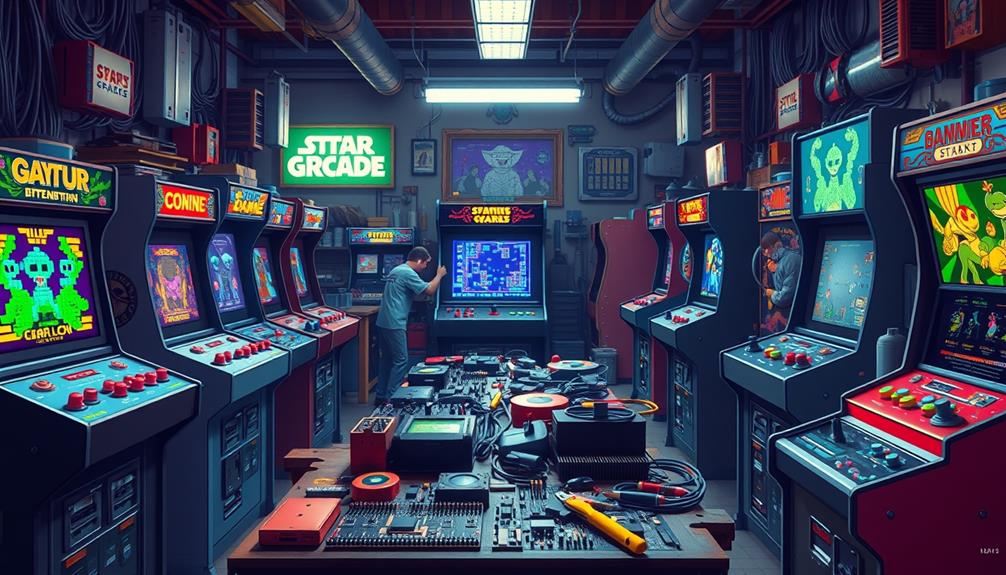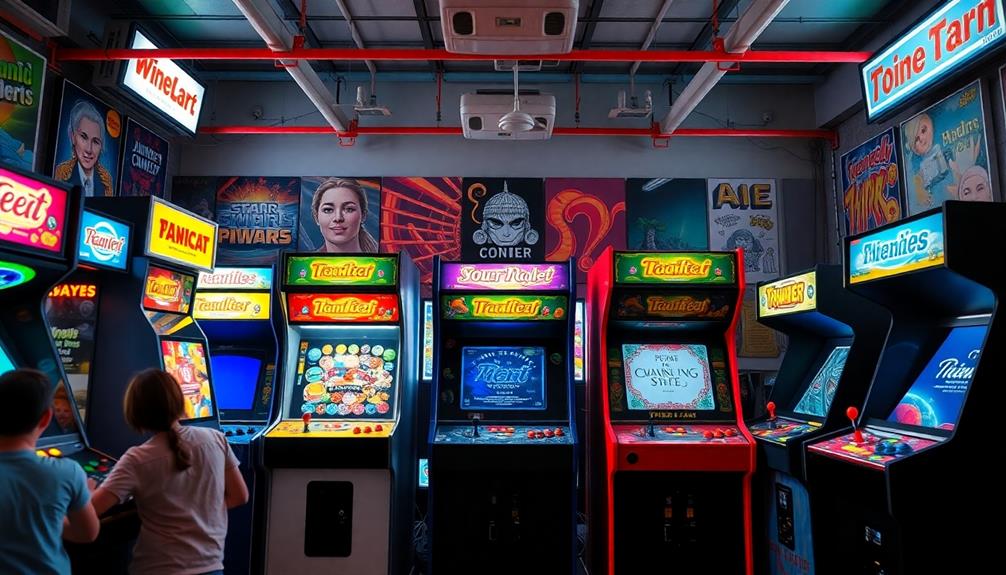The original arcade games were innovative in their simplicity, with a focus on straightforward gameplay and basic graphics. Games like Computer Space, which was intricate but not widely embraced, and Pong, the first major success that captured the attention of numerous players with its simple mechanics, were among the first. These initial games created a competitive environment, motivating players to strive for high scores and exchange experiences with their friends. They paved the way for a thriving arcade culture, laying the foundation for future advancements. If you’re interested in learning more about how these games evolved and influenced gaming, stay tuned to discover more intriguing details.
Key Takeaways
- The first arcade games, like Computer Space, featured complex mechanics that often overwhelmed players, leading to limited commercial success.
- Pong revolutionized arcade gaming with its simple mechanics, achieving significant commercial success and establishing the arcade gaming market.
- Early games relied on basic graphics and sound, focusing on straightforward gameplay to attract players.
- Titles like Space Invaders introduced competitive elements, such as high scores, fostering player engagement and community interaction.
- Arcades served as social hubs, creating a diverse gaming audience and encouraging a competitive atmosphere among players.
Early Coin-Operated Games
In the early 1970s, as gaming began to revolutionize entertainment, the first coin-operated arcade games emerged, enchanting audiences with their novelty. Computer Space, released in 1971, was the first commercially available arcade video game, but it struggled to attract players due to its complexity and high difficulty.
That same year, the Galaxy Game followed, introducing a coin mechanism while offering a version of the classic Spacewar!, yet it remained relatively obscure. These early machines set the stage for future innovations in arcade gaming, including the rise of best arcade machines that would captivate players in their homes.
Everything changed in 1972 when Pong launched by Atari became the first commercially successful arcade game. Its simple mechanics and engaging gameplay led to the sale of over 35,000 units by 1973, capturing the public's imagination.
The momentum continued with the 1978 release of Space Invaders, which established the shoot 'em up genre and generated massive revenue, with over 100,000 machines sold in Japan alone by year's end.
These early arcade games often featured basic graphics and sound, relying on straightforward gameplay to attract players. This simplicity laid the groundwork for future innovations in arcade gaming, paving the way for a burgeoning industry and a new form of entertainment.
The Rise of Video Games

The rise of video games in the late 1970s and early 1980s revolutionized entertainment, enthralling millions with their engaging gameplay and competitive spirit. The journey began with the first arcade game, "Computer Space," released in 1971, which laid the groundwork for coin-operated video games.
However, it was Atari's "Pong," launched in 1972, that truly marked the dawn of commercial arcade video games, selling over 35,000 units by 1973 and mesmerizing players with its simple yet addictive mechanics. This era also saw the emergence of pinball machines, which were gaining popularity in arcades, and featured innovative designs like flippers that enhanced player interaction and excitement (history of pinball machines).
As the video game industry blossomed, 1978 saw the introduction of "Space Invaders," which initiated the Golden Age of arcade games. This iconic title not only established the shoot 'em up genre but also became a cultural phenomenon, selling over 100,000 machines in Japan within the year.
Early arcade games fostered competitive gameplay, encouraging players to chase high scores and engage with one another, creating a vibrant community around these machines. The excitement of competing for the top spot on the leaderboard became a hallmark of the era, setting the stage for the dynamic world of gaming that continues to evolve today.
Cultural Impact of Arcades

Arcades became vibrant social hubs where friends gathered and strangers bonded over their shared love for gaming.
The cultural significance of arcade gaming can't be overstated. They created a unique environment that fostered community while paving the way for competitive gaming.
With the rise of popular arcade titles, such as Jennifer Aniston and Brad Pitt's friendly connection, the gaming landscape began to change, drawing in diverse audiences.
Here are three key impacts:
- Diverse Gaming Audience: Titles like Pac-Man expanded the demographic, attracting a significant number of female gamers and diversifying the gaming community.
- Competitive Atmosphere: Games like Space Invaders introduced high scores, igniting a competitive spirit among players and making arcade gaming a thrilling experience.
- Foundation for Modern Esports: The emergence of video game tournaments in the 1980s, organized by groups like Twin Galaxies, laid the groundwork for what we now recognize as modern esports.
Innovations and Key Figures

With the rise of arcade culture, innovations and key figures played a pivotal role in shaping the gaming experience. Nolan Bushnell and Ted Dabney co-invented "Computer Space" in 1971, paving the way for the first commercially successful arcade game, "Pong," released by Atari in 1972. This simple table tennis game achieved immense popularity, selling over 35,000 units by 1973.
The charm and allure of arcade games fascinated players, much like how astrology claims to influence personality traits and attractiveness.
As the years progressed, Eugene Jarvis introduced dynamic innovations with "Defender" in the early 1980s, featuring dual-joystick controls that transformed arcade gameplay.
Meanwhile, Toru Iwatani's "Pac-Man," launched in 1980, became a cultural icon, fascinating players with its whimsical design and character-driven gameplay. This non-violent mascot character broke the mold, selling around 350,000 units worldwide.
The release of "Donkey Kong" by Nintendo in 1981 marked another milestone, introducing Mario and establishing the platformer genre.
These key figures and their innovations not only enriched arcade gameplay but also laid the groundwork for future gaming experiences, emphasizing character development and engaging narratives that would resonate with players for decades to come.
Evolution of Arcade Experience

As players flocked to arcade venues, the evolution of the gaming experience became evident through advancements in technology and design. The first arcade games, like Computer Space and Pong, were simple games with basic mechanics.
However, the landscape changed dramatically with the introduction of games that offered more than just gameplay, much like how Blue Skies and Lemonade captures the essence of joy and nostalgia in music.
Here are three key developments that shaped arcade gaming:
- Enhanced Player Engagement: With Space Invaders, high scores became a driving force, encouraging players to compete for the top spot.
- Narrative Elements: Pac-Man introduced a storyline and characters, appealing to a broader audience, including female gamers.
- Competitive Atmosphere: The rise of video game tournaments in the 1980s brought players together, setting the stage for modern esports.
These changes transformed arcades into vibrant social hubs, where players not only pursued high scores but also engaged in friendly rivalry.
The evolution of arcade experience reflected a shift from simple game mechanics to complex interactions, ensuring that the spirit of competition and community remains a cornerstone of arcade gaming today.
Frequently Asked Questions
What Were the First Arcade Games?
The first arcade games were simple and focused on skill. You'd control a character or object, often facing challenges like shooting or dodging. They laid the groundwork for more complex gaming experiences that followed later. The first arcade games were a cultural phenomenon, drawing large crowds to arcades and driving the popularity of video games. They paved the way for the evolution of gaming technology, inspiring future generations of game developers to push the boundaries of what was possible. The success of these early arcade games set the stage for the multi-billion dollar gaming industry that exists today.
How Did Old Arcade Games Work?
Back in the day, old arcade games worked like clockwork. You inserted a coin, then controlled simple mechanics—like moving paddles or ships—while sound effects added excitement, pulling you deeper into the action.
What Were Arcades Like Before Video Games?
Before video games, arcades were vibrant spaces filled with pinball machines, skee ball, and slot machines. You'd enjoy the atmosphere, socialize with friends, and test your skills, all while sharing the excitement of coin-operated entertainment.
Were Arcade Games 16 Bit?
No, arcade games weren't 16-bit initially. You'd find simple graphics and basic gameplay instead. As technology advanced, 16-bit graphics emerged, transforming the gaming landscape and delivering more vibrant visuals and engaging experiences.
Conclusion
In the end, the first arcade games didn't just entertain; they laid the groundwork for a gaming revolution. They captured imaginations, ignited friendships, and created spaces where fun thrived. As you think back on those pixelated pioneers, remember: every joystick moved, every coin dropped, and every high score achieved was a step toward the vibrant gaming culture you enjoy today. So, let's celebrate those early moments that sparked an endless quest for adventure and connection.









